The 3-Day Method of Potty Training
An important note: below, I’ve outlined some [optional] tools you can use. Please don’t feel like you have to do All. This. Stuff… in order to potty train your kiddo. You could also keep it simple and follow the basic method without any of the add-ons. Bottom line: Don’t feel like you need to go crazy with it. Do as much or as little as you feel like.
Potty Training in a Weekend (or 3-Day Weekend)…
Task #1 in the 2/3-day method of potty training is to figure out when is the best time to train. Give yourself a few weeks to prepare so you don’t feel rushed.

If you stay at home with your kiddo, anytime is good.
For working parents, a week-long holiday is ideal (Christmas break, Spring break, etc.), but a three-day holiday weekend will suffice, especially if your child is a little older (older than two or so). Summer works great because being naked is easy, but winter works too – especially during bad/cold weather when you’re cooped up inside anyway.
Once you’ve picked your dates, clear your calendar for those days: definitely all day on the first day and perhaps you can practice short outings on the second day if you’re up for it. You can get out more on the third day, and so on.
I really feel this is an all or nothing thing; don’t do it half-assed.
You want to avoid the anxiety of taking your child somewhere where having an accident is unacceptable. Remember: when you start this method, you are done with diapers – and the last thing you want to do is waver and put a diaper back on him; this will only undermine the process.
Bottom line: The less stressed you are, the better, so don’t plan on taking your child anywhere where having an accident would freak you out during “The Big Weekend.”
Oh Crap Potty Training: A Very Good Book
I am in no way, shape, or form a potty training expert. I simply read all the popular books on the subject and combined the information with my personal experience to summarize this technique.
My favorite book that I came across in my research (from an actual expert) is Oh Crap Potty Training by Jamie Glowacki.
You can get through Chapters 1-5 in a couple of hours, and then you will be VERY well prepared for this endeavor. I recommend you do so if you are on the [ahem] “apprehensive” side of the spectrum.
Others may find this article on 2 – 3 day potty training sufficient.
Gearing Up for Potty Training
Once you have your dates marked on the calendar, it’s time to gear up. Here is our complete guide for potty gear.
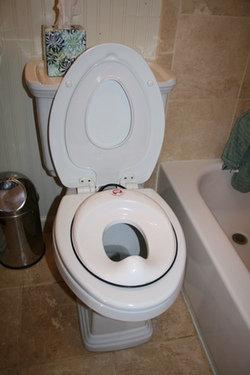
You will need:
- A potty seat or potty chair
- Underwear – Target, Amazon, etc.
- Stool(s)
Optional:
- A potty doll
- Potty books/movies
- Treats/juice
- Flushable wipes
- A piddle pad (for the car)
Preparation
Optional — Potty Books and Movies
For the days and weeks leading up to D-Day (let’s call it “P-Day,” teehee), many parents find it useful to read potty books and/or watch some potty movies to get your kiddo excited. Some favorites include:
Sesame Street: Elmo’s Potty Time ~ $10
Get it on Netflix, iTunes, or Amazon.
And check out some favorite Potty Books here. Note: You can probably borrow most of these from your local library.
Optional — Potty Doll
Some parents use the potty doll as a learning tool – it’s also a fun, new toy to play with during P-Weekend. The gist is that you show your little one how the doll works, then ask him/her to train the doll. This is one of the original tools used in Nathan H. Azrin and Richard M. Foxx’s technique in Toilet Training in Less than a Day.
Most little girls love dolls, especially those who are on the nurturing side, but lots of little boys love dolls too.
The potty doll of choice is the Melissa & Doug Mine to Love Annie Doll (or the dark-skinned potty doll).
Optional — Cool “Character” Underwear
Some kids get really excited about wearing underwear, especially if it features their favorite character. Use this to your advantage! Before P-Day, go out and buy your child his favorite character underwear.
For Alice, we bought Frozen underwear (Anna and Elsa), some My Little Pony underwear, and some Dora the Explorer ones. GET LOTS OF UNDERWEAR. There will be accidents, and you don’t want to run out.
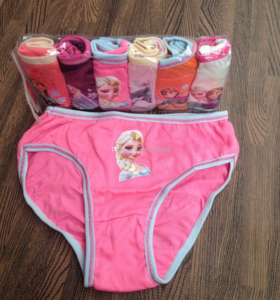
Since your child holds these characters in high regard, you would tell them, for instance, to “keep Elsa dry.” Elsa does NOT want you to poop or pee on her. Most kids get this. Again, just another tool in your arsenal.
Define Your Space
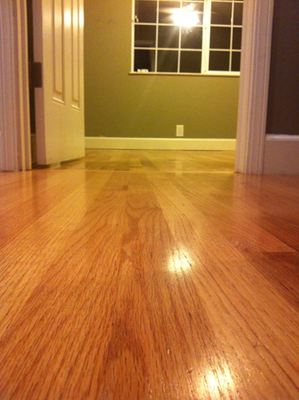
During the Big Weekend, it’s helpful to define a “safe space” where your child can roam and hang without you stressing about accidents, because they will happen. Ideally, this is a non-carpeted area, like hardwood or tile. If your whole house is hardwood, you’re in great shape. If you have fine rugs or carpets (let’s hope you don’t!), keep those areas off limits during P-Weekend – or even better, roll up your area rugs and set them to the side for a week or two.
If it’s warm outside, your backyard is a great place to be as well.
Again, the goal is to have a safe space for potty training so mom and dad can stay cool and not freak out when the fine Persian rug gets pooped on.
P-Weekend
What do you do?
In a nutshell, during these two (or three) days, your child is simply going about his day doing his thang: playing with toys, doing arts and crafts, playing games – or whatever else he enjoys. Except, naked in the “safe area” and going to the potty.
A lot.
I suggest you line up some new things to do so everyone stays entertained, but not SO entertained that they can’t pull themselves away to go potty. For example, don’t get so engrossed in a movie that you can’t pull him away to go potty. Activities that provide for shorter/finite durations are better.
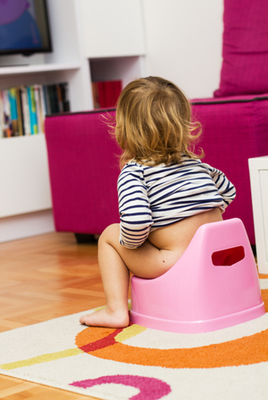
Okay, ready???
Don’t worry, every little thang gone be alright. =)
Potty Training Day 1
Once everyone wakes up, it’s party time! Some parents make a big deal of P-Day, others do not.
I like to hold a silly ceremony where I pronounce the end of diapers, then throw the diapers away (don’t really throw them away [obviously], you’ll need them for naptime and nighttime, for now).
The gist is: “You’re a big girl now, no more diapers!” [High five.] Yay!
Clothes off!
During Day 1 (and perhaps Day 2), you want there to be as little between your kid’s butt and the potty as possible. Naked is good. A shirt (only) is fine too. A short dress works well, as long as it doesn’t get in the way. If it’s cold in your house, crank up the heat a bit. You can use socks to keep their feet warm. Leg warmers are perfect too, but you definitely want unobstructed access to the crotch.
During Day 1, the idea is that you want your kid to pee a lot so he can get as much practice as possible in a short period of time. If your kid only pees every two hours or so, it’s not really enough to reinforce the concept (it’s too bad we can’t give them coffee, LOL).
So.
Load your kid up with more fluids than normal. Many parents use juice as an incentive, especially if your kiddo isn’t used to getting juice. Warning: they will drink a boatload of juice if you let them! Don’t do what I did, which was to give her so much apple juice that it gave her diarrhea (and you’re taking advice from me? This is scary). Mixing juice with water is a good middle ground.
Now, we will be going to the potty to pee every 15-20 minutes or so (more often, if needed – you be the judge) – and to poop as needed (harder to predict). You have to find the fine line between annoying your kid to death and having accidents.
Stay close to the potty so it’s not a long haul to get there. Alternatively, you can bring the potty chair to whatever room you’re in. Or outside, even. Bottom line: Don’t stray too far from the potty or toilet during this weekend.
If you load him up with fluids and bring him to the potty, something miraculous will happen: he will pee in it!! Celebrate the glorious sound of tinkles. Woohoo!
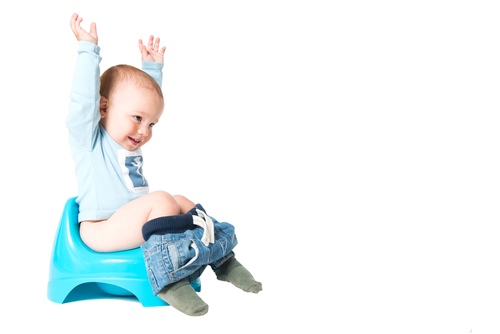
Optional — Treats!
Lots of parents (self included) use treats as an incentive to poop or pee on the potty (or toilet). A perfect treat is something small, like M&Ms, so they aren’t completely overcome with sugar. For my second kiddo, I used chocolate raisins, which are also nice and small – and she LOVES them. Other ideas include sweet tarts, gummy bears – anything that’s small and non-messy will work just fine. Stay away from chocolate, as it tends to melt quickly and makes a mess.
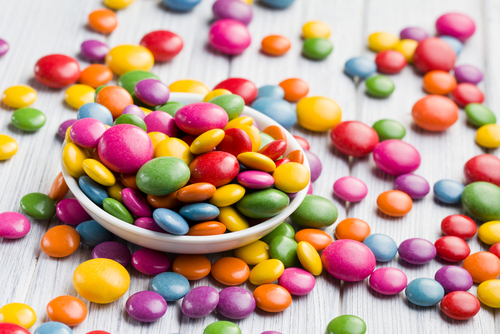
Some people frown upon “bribery” for using the potty – and by all means, you don’t have to do it. Just remember, bribery is asking someone to do something illegal – and going on the potty isn’t illegal. 🙂
“Will your kid ask for treats forever?” No, after a couple of weeks, they start using the potty like normal and forget about the treats (although, sometimes she still asks for a treat just to see). You phase them out over a week or so.
At Attention!
The most important thing to note during the training days is that the parent on duty must give the child his/her full and undivided attention. This is why it’s useful to take shifts, because as you know, this can be quite exhausting (LOL).
Mom or dad, your job is just to hang out and play with your toddler, enjoy your time together, all while taking him/her to pee on the potty every 20 minutes – OR as soon as you see her start to pee, whisk him/her off to the pot. After a good 3-4 hours of this, you should start to see real progress!
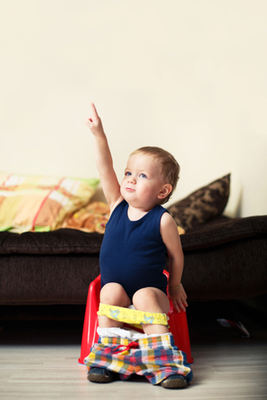
Note: it’s important to take him to the potty – as though it’s a thing you just do.
Try not to ask, “Do you need to go?”, “Do you need to go?” Not only is this annoying, but the answer will almost always be no.
Instead, get into the habit of saying, “It’s time to go to the potty!” If he insists he doesn’t have to go, maybe he doesn’t, but if he has an accident one minute later… you’ll learn these things as you go. Mistakes will be made and it’s okay.
When you take him/her to the potty, and he goes, GREAT! {Treats, praise, etc.} If he doesn’t, that’s okay. Nobody has failed, we just try again next time. What you don’t want to do is sit on the potty all day waiting for something to come out. There is no better way to burn yourself out than by doing that. And it’s not really accomplishing anything. We want wins, people! And lots of ’em.
The eventual goal is to have your child initiate going on her own, without any prompting. For many, this is achieved in two days. For others, it may take a week. Even two. But it will happen. For now, you need to initiate trips to the potty until she gets the “muscle memory.”
Accidents
Accidents will happen, don’t get discouraged. Use them as learning opportunities. Try not to say, “It’s okay.” It’s not the end of the world, but we really want them to know that from now on, pee and poop go in the potty. If it’s too “okay,” they might think it doesn’t matter. Instead, say, “Oops! You had an accident. Pee and poop go in the potty.”
It’s just one of those little things. 😉
Whatever you do, don’t freak out at the sight of accidents – this will only scare them. It’s really natural for us to freak out at the sight of poop on the floor (it’s gross, right?), but try to refrain. Again, “Oops! You had an accident. Pee and poop go in the potty.”

Poop
About the poop… keep in mind that the feeling of pooping on the potty is totally foreign to your child – and can be a little scary. Remember: it feels like something is falling out of them (their guts, perhaps?). Scary stuff. (Remember what it felt like to push a baby out for the first time? Eek.) This is why many kids may have a harder time with #2 than with #1.
They may be frightened that it’s coming out. Say something like, “Let it come out, it’s ok…” or “Let it fall out, you’re doing great!” etc., etc. Bottom line: Anything you can do to make the pooping less scary is a good thing. Be prepared to lend your moral support.
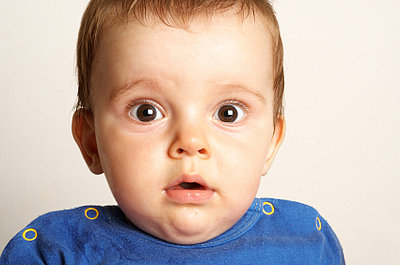
*If your child is straining to poop, it’s not normal — he’s probably constipated. This can make potty training extra difficult. Parents: it’s time to reel in his diet. Less: processed foods, crackers, pasta, bread, cheese, milk, etc. More: fruit, vegetables, and whole grains. Sometimes the process of potty training is a good wake-up call.
If they seem to desire more privacy when pooping, give it to them by stepping away for a moment. Sometimes, this works wonders. Some children are naturally more modest than others.
Okay, it’s the end of Day 1. Hopefully, you had lots of successful pees in the potty. Maybe a poop or two. *You will find that without diapers, your kiddo will poop less frequently, and that’s okay. As long as he’s not “holding it.”
Now go to bed; you done good! Diapers or pull-ups at night and during naps are okay for now. Night training will happen naturally in time. Keep reading…
Day 2
If Day 1 went really well, you can try the second p-word… “pants!” If Day 1 did not go well, stay naked. You have to be the judge of when the right time for pants is.

Notice I said pants, not underwear. Underwear might be too reminiscent of a diaper. That said, if your kid is doing really well and you think she can handle it, by all means, go for underwear and pants together. We went straight to underwear + pants, and it was fine.
Pants
During these first few weeks, it’s important that pants are easy to get on and off. Yes, you (or someone) will be there to help, but we really want to build confidence and decrease obstructions between the BOTTOM and the POTTY.
If he has truly connected the dots between feeling the urge to go… and going, then pants shouldn’t be too much of an impediment.
For little girls, the easiest thing is dresses with tights. Leggings are fine too.
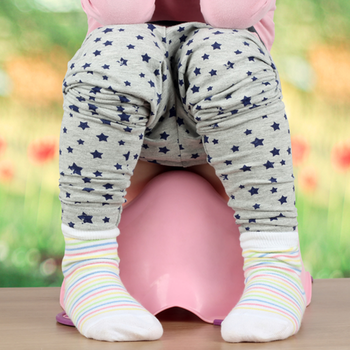
For boys, stick to pull-on pants with elastic waistbands. For all kids, steer clear of jeans or pants with a button and a zipper (for now) – those are the hardest to manipulate when speed matters.
Day 2 goes on like day 1, except with pants (assuming you had success with the naked phase). Again, lots of fluids. Having fun. Going to the potty every 20-30 minutes, or however frequently you feel is right for your child.
Everything else should basically be the same. If you are introducing underwear at the same time (funnn!), remember you have a new tool: “Keep Elsa dry!”
You should still be giving your child your undivided attention and correcting any accidents: “Remember, poop and pee go in the potty; now let’s clean this up.”
Stay positive. Use your tools (potty doll, treats, keep Elsa dry, etc.).
If the morning goes well and you’re feeling confident, try a short outing. The perfect first outing is a walk around the block. Kick off your outing with a successful pee. In fact, you’ll get in the habit of using the potty every time before you leave the house, so now’s a great time to start.
Once you get an outing under your belt, you’re in great shape! Things just progress from there and you won’t feel like you live under house arrest.

Over time, a few things will happen: 1) your child will tell you when he has to go, and 2) you won’t need to use tools, like treats, etc., until one day (usually after a couple of weeks) – he’ll go on the potty like it’s nothing new – he may even go all by himself.
Yay, you did it!
There you have it, my friends. The two-day method may require lots of attention and effort, but it is, in fact, quite simple.
Napping and Nighttime
When to wean off diapers for naptime and nighttime is all over the board. Many kids can learn to sleep through a nap AND through the night without a diaper just a few weeks after daytime training. You’ll know when the time is right when she can keep her diaper totally dry for a week at a time.
You may still have to get up in the middle of the night to take him to pee. I mean, heck, most adults get up to pee once or twice a night (especially after having babies, lol).
On the other hand, some kids will stay in nap and nighttime diapers for quite some time. Shoot, I even know six-year-olds who sleep in pull-ups due to bed-wetting – boys seem to have a harder time with this than girls.
The important thing to remember is to take the diaper or pull-up off FIRST THING in the morning so she doesn’t lapse back into (consciously) peeing in them. Explain to her that diapers are just for sleeping and get into the habit of taking her to pee right before putting on her nighttime or naptime diaper.
Daycare, Other Caregivers, Etc.
Be sure to tell your daycare, nanny, and so forth, exactly what’s going on and ask them to carry on your work. After all, it’s in their best interest to help, no?
When we were training Lucie, I had a very uncooperative caregiver who refused to take her regularly, and miraculously, she went on her own. It all worked out okay!
Again, try not to revert back to diapers at daycare, particularly if you’ve made good progress at home. Kids have a really hard time understanding exceptions to rules and thrive on consistency.
Again, Jamie addresses all of these issues – and other problem areas in her book.
Summary
Hey, mate, you can do this! Don’t be afraid. Be cool, calm, and confident, and your child will follow your lead. Giving your child the gift of potty training is a great thing! You’ll be so proud of your kid (and yourself! LOL) when you’re done.
Good luck!!
Back to:
- Part I: Introduction
- Part II: Potty Training Methodologies
- Part III: Potty Gear
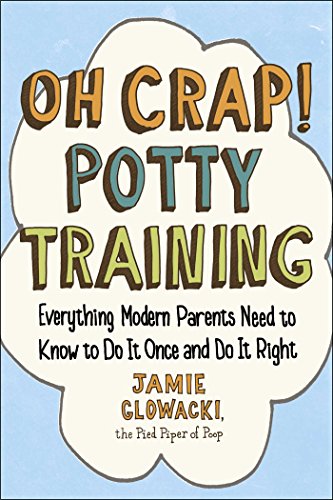
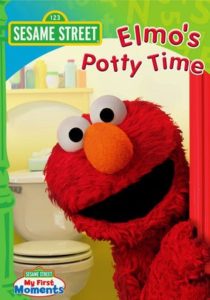
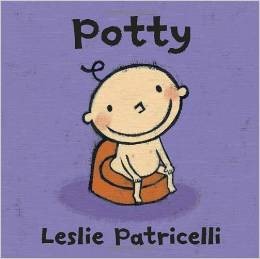
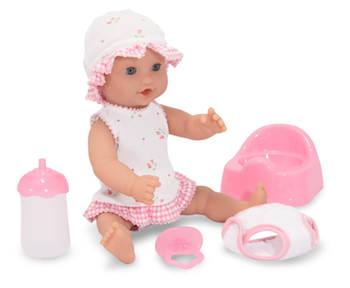
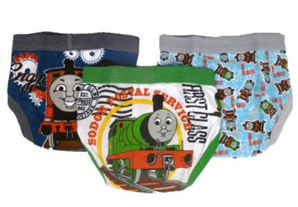
Good Article
Thank you for this! We are starting potty training tomorrow and I am super excited. This was exactly the kind of thing I’ve been looking for (heard and planned a lot of random stuff, I just needed it all together to reference during potty training to keep my bearings ) 😊
Hi! Thanks! So we have started this method two days ago after reading the Oh Crap! Book and even when trying to give my 26 year old tons of liquid, she only goes every 2 hours or so. How can I get her to pee more? I feel the infrequent pee is delaying her “getting it”… Also, she is aware that she has to go and will either bring a diaper to me or say “potty” but then when I put her in the potty she will hold it for at least 20 minutes until she can’t any longer… any tricks on how to get over this? I feel like she is ready because she says when she has to go and we have caught all her poops this way, but hanging out at the potty for 20 minutes each time I think defeats the purpose of feeling the “urge” and acting on it.
Thanks!
Great article! When we trained my little niece last year, it took more than two days to learn. It was quite frustrating, especially when it seem like she was having fun from the process.
But then with time she learnt well and use the potty without our supervision, only comes so we can clean her up…
I’ve been at a loss on how to potty train my little one but now I know better.
I’ve been at a loss on how to potty train my little one but now I know better. I”ll give it a try.
About how long should we leave them on the potty each time? And approximately how long before they go in the potty versus on the floor on the first day?
My best successes have been to leave them on for no longer than a few minutes or until they start playing instead of having the far away look of concentrating on the feeling of peeing. You don’t want the process to become a game, fun but not playing with other things including the potty! If after a few minutes they lose interest or no results, let them leave the potty but come back to it in a little less time than you would usually wait between potty trips. Good Luck!
Please stop promoting the so-called “flushable” wipes that are destroying our sewer systems. Just use regular wipes and throw them in the trash. Otherwise, good article.
Done.
Great article, thanks for summing up everything that can help a parent jump-start their potty-training session. I am in the process of starting to potty-train my 2.5-year old and need all the tips I can get.
Thanks a lot for the tips!
I start potty training Friday (2/26/21) for my 26 month old son. He models going to the bathroom when I go. Why do I feel nervous? I am confident we will both do great especially with your guidance. I bought the supplies yoy suggested awhile back. Will keep your readers updated on our outcome.
Thoughts? My child had solid Day 1; successful trips to the potty and only 1 accident. Day 2: 1 successful trip to the potty, the rest were accidents due to refusing. Day 3: holding and refusing to go.
A very good summary of an excellent book! Every little detail is important and worth following closely. The book itself illustrates, reinforces and explains in full which is great for feeling confident and prepared.